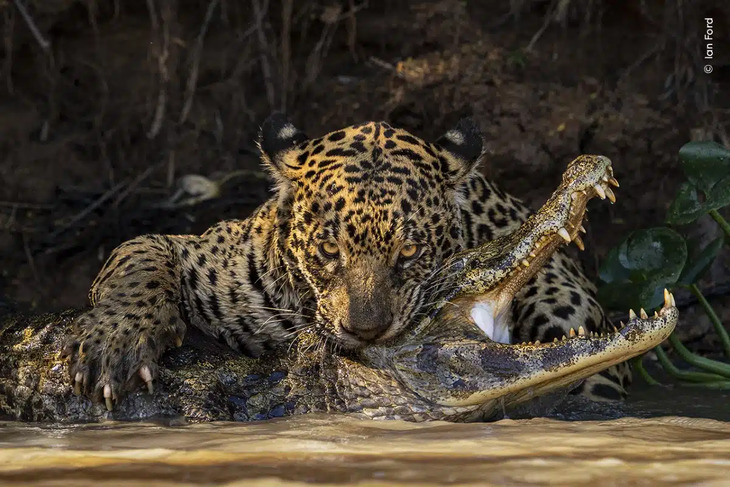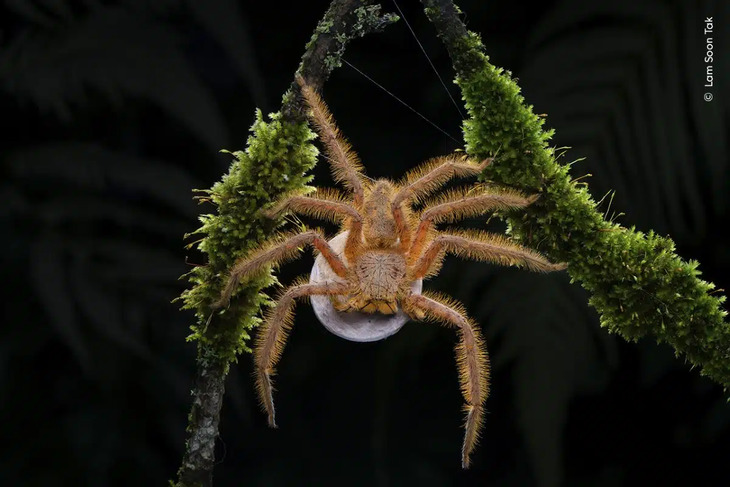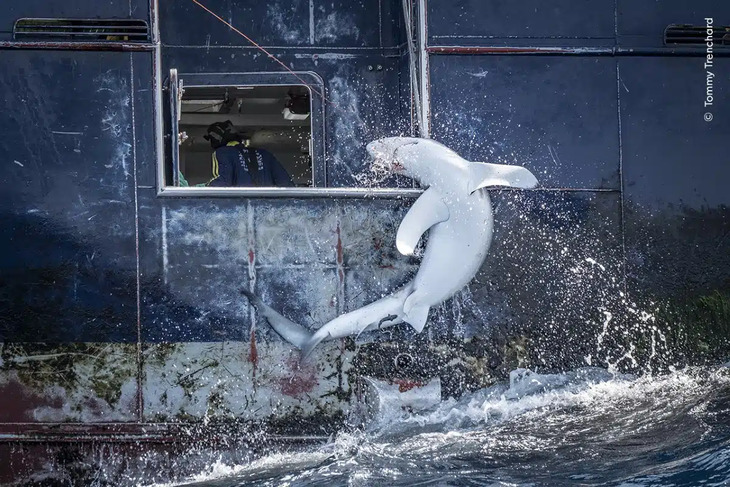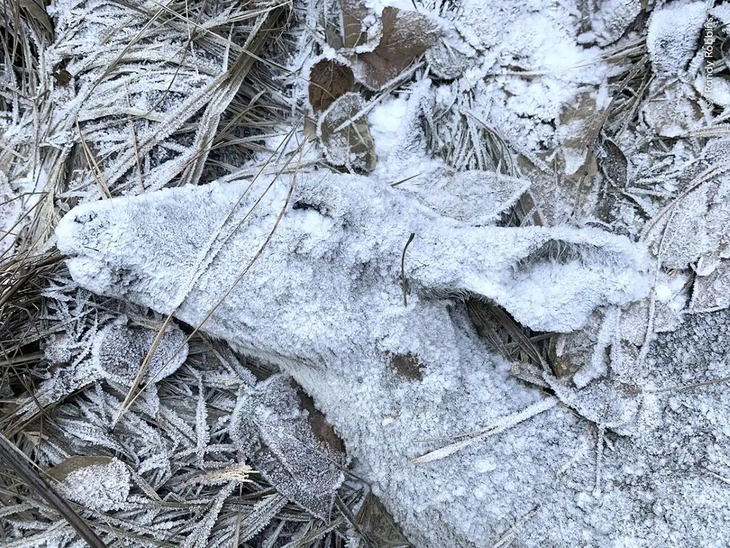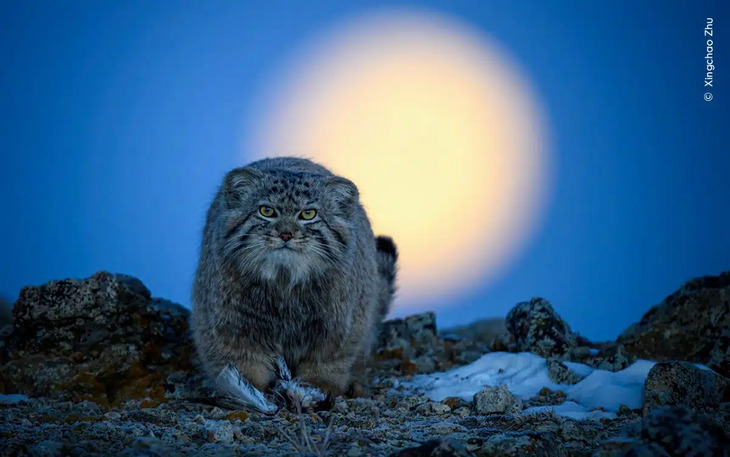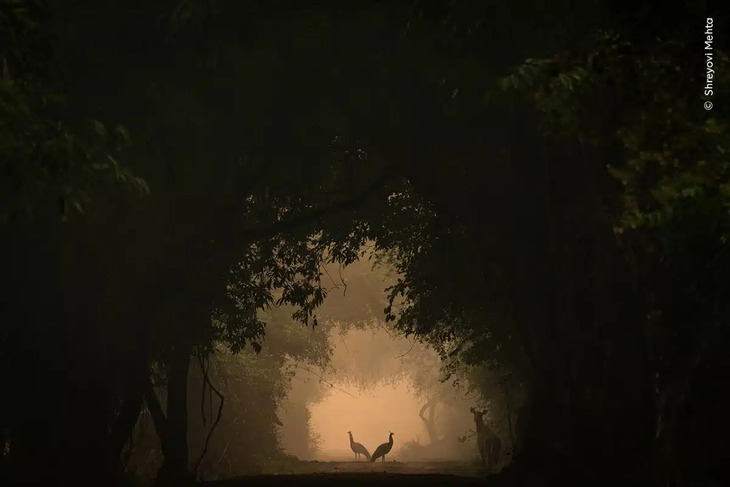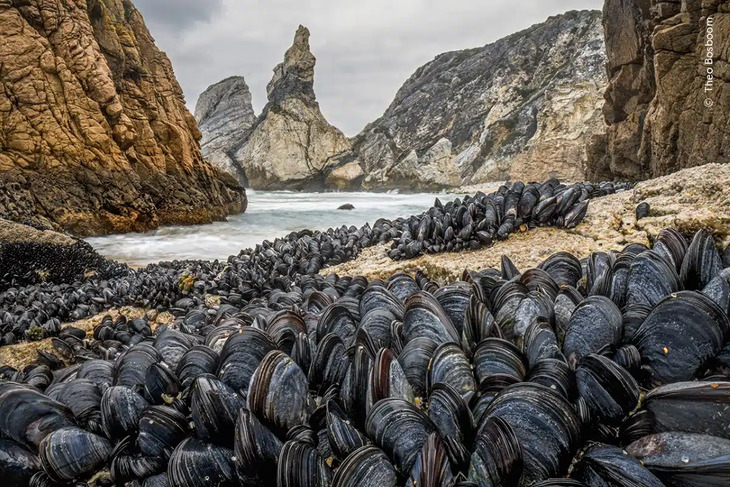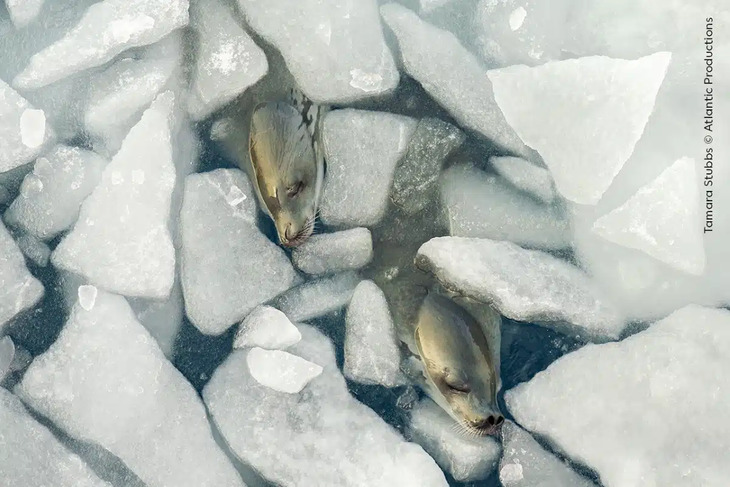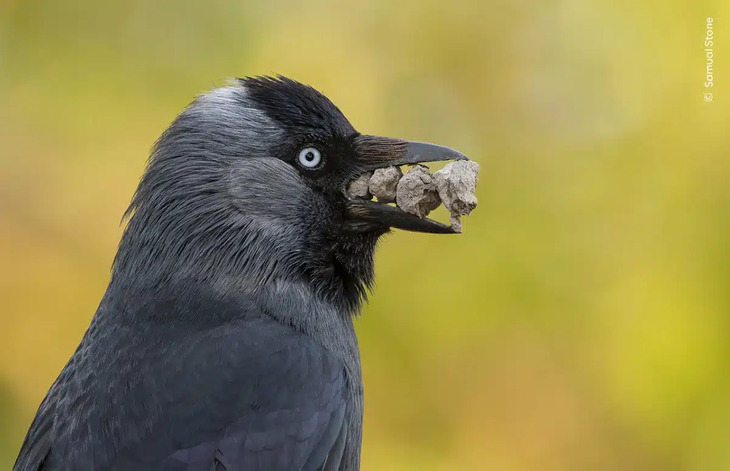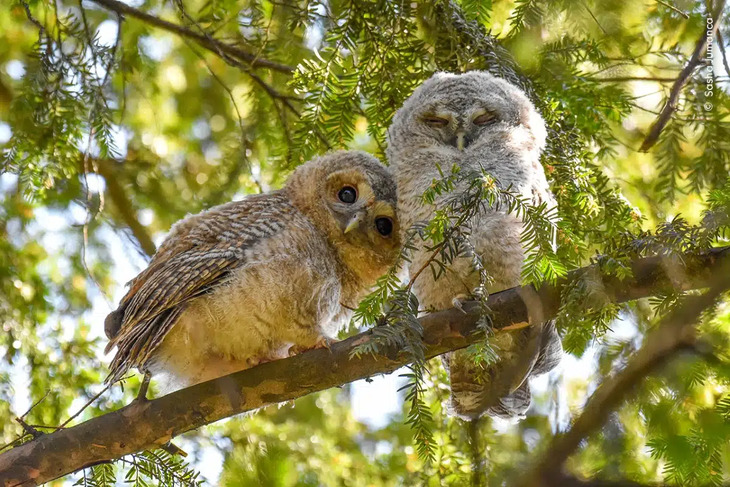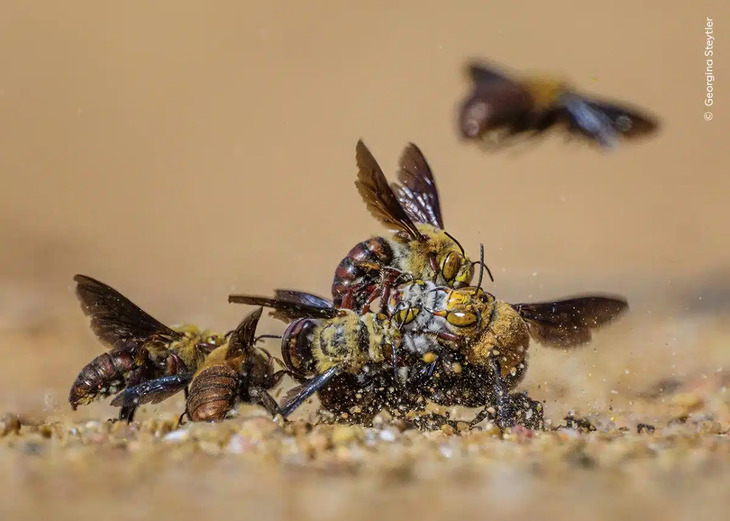Ian Ford captured the dramatic moment a jaguar delivered a fatal blow to a caiman in the Pantanal in Brazil. The Pantanal, home to the world's highest concentration of jaguars, is a predator's paradise. With ample prey, these typically solitary big cats have been observed socializing and even fishing together.
2. “Ziggy Spider” © Lam Soon Tak, Wildlife Photographer of the Year. Highly Commended, Behaviour: Invertebrates
While exploring the lush highlands of Malaysia, Lam Soon Tak stumbled upon a remarkable arachnid. Perched on a broken branch near a river, a vibrantly colored spider carrying a bright white egg sac caught his eye. The spider’s orange body and the striking disc of eggs in its jaws were a stark contrast against the vibrant green moss.
This unique creature is known as the David Bowie spider, named after the iconic musician due to its striking resemblance to his 1970s makeup. Found in Southeast Asia, this spider is a testament to the incredible biodiversity of the region.
3. “Stormy Scene” © William Fortescue, Wildlife Photographer of the Year. Highly Commended, Behavior: Mammals
Against a picturesque backdrop of storm clouds illuminated by the setting sun, William Fortescue witnessed a breathtaking display of natural beauty. During the rainy season in Serengeti National Park, he observed multiple mating sequences between lions.
While the female eventually broke off the encounters, it was only upon closer examination of an enlarged image that William noticed the intriguing details: the saliva trails and the swarm of insects attracted by the male's mane.
This phenomenon shows how important synchronized births within a pride are to increasing the chances that cubs will survive to adulthood. The female lions in a pride cooperate to make sure their babies are okay, including shared parenting.
4. “Hooked” © Tommy Trenchard, Wildlife Photographer of the Year. Highly Commended, Oceans: The Bigger Picture
Tommy Trenchard, aboard the Greenpeace ship Arctic Sunrise, captured the tragic scene of a requiem shark struggling against its capture in the South Atlantic Ocean. The shark’s body, arched in defiance, was a stark reminder of the devastating impact of bycatch on marine life.
The expedition aimed to expose the rampant issue of unregulated industrial fishing, which has led to a decline of over 80 million sharks annually worldwide. Since 1970, shark populations have plummeted due to fishing practices, with three-quarters of all species now facing extinction.
5. “The Last Resting Place” © Randy Robbins, Wildlife Photographer of the Year. Highly Commended, Natural Artistry
Randy Robbins stumbled upon a breathtaking scene in the California wilderness: a deer, frozen in time by the winter frost. On a chilly morning near Susanville, he discovered the deer’s body while checking trail cameras. Seizing the moment, he captured the poignant image with his smartphone before the ice could melt.
6. “Twist and Jump” © Jose Manuel Grandío , Wildlife Photographer of the Year. Highly Commended, Behavior: Mammals
Braving the frigid temperatures of Athose, France, Jose Manuel Grandío captured an incredible moment of nature. On the final day of his winter photography expedition, he witnessed a stoat leaping through the air with incredible agility. The small mammal’s playful antics, which scientists refer to as “dancing,” seemed to be an expression of pure joy as it frolicked in the fresh snow.
While the exact motivation behind this behavior remains debated, from predator confusion to potential health issues, it’s a fascinating sight that shows the stoat’s incredible athleticism.
7. “Moonlight Hunter” © Xingchao Zhu, Wildlife Photographer of the Year. Highly Commended, Behavior: Mammals
After days of tracking Pallas's cats during the Chinese New Year in 2023, Xingchao Zhu was rewarded with an unforgettable scene. As the moon dipped below the horizon, Xingchao found himself face-to-face with one of these elusive creatures, its thick winter coat a testament to its remarkable adaptability to the harsh environment. The cat's low, rounded ears and stealthy movements allowed it to navigate the plateau's challenging terrain while avoiding larger predators.
8. “In the Spotlight” © Shreyovi Mehta, Wildlife Photographer of the Year. Runner-Up, 10 Years and Under
On a family outing to Keoladeo National Park, Shreyovi Mehta was delighted to stumble upon two Indian peafowl posing for what seemed like a photo shoot. She quickly grabbed her father's camera and got down on the ground to capture this ethereal shot.
Keoladeo, a birdwatcher's paradise, is teeming with water birds in winter. Peafowl, however, are permanent residents of the park, spending their days resting in the shade of tall trees and venturing into open areas at dawn and dusk.
9. “The Disappearing Ice Cap” © Thomas Vijayan, Wildlife Photographer of the Year. Highly Commended, Oceans: The Bigger Picture
Thomas Vijayan’s drone captured the awe-inspiring scale of the Bråsvellbreen glacier, part of the Austfonna ice cap in Svalbard, Norway. The glacier's breathtaking summer spectacle of meltwater cascading over its edge is presented in this panorama, stitched from 26 individual frames.
Austfonna, Europe’s third-largest ice cap, is one of several covering Svalbard’s land area. Alarmingly, scientific projections indicate that Svalbard’s glaciers could vanish entirely within 400 years due to the accelerating effects of climate change.
10. “Strength in Numbers” © Theo Bosboom, Wildlife Photographer of the Year. Highly Commended, Animals in their Environment
In a stunning display of nature's resilience, Theo Bosboom photographed mussels forming a protective cluster on Praia da Ursa. The image, captured with a probe lens, showcased the mussels' unique ability to withstand the ocean's forces by banding together. Theo's work often celebrates the often-overlooked beauty and importance of lesser-known species.
Mussels play a crucial role in marine ecosystems, purifying the water and providing a habitat for other invertebrates. Their presence is essential for maintaining a healthy ocean environment.
11. “Going with the Floe” © Tamara Stubbs and Atlantic Productions, Wildlife Photographer of the Year. Highly Commended, Animals in their Environment
During her Antarctic expedition, Tamara Stubbs witnessed crabeater seals napping peacefully amidst the sea ice, their noses barely breaking the surface of the water. Two seals, in particular, had drifted close to the ship, enjoying the gentle rocking motion.
Despite not being endangered, these adorable creatures are protected by international conservation efforts. However, more research is necessary to assess the potential threats posed by climate change and tourism to their populations.
12. “Precious Rocks” © Samual Stone, Wildlife Photographer of the Year. Highly Commended, Behavior: Birds
Samuel Stone observed a pair of jackdaws diligently constructing their nest in the hollow of a fallen willow tree in London's Bushy Park. The clever birds, known for their adaptability, were gathering a variety of materials, including twigs, feathers, wool, and even stones, to create their new home. Samuel had previously noticed the jackdaws carrying bits of hair from the local deer, adding a unique touch to their nest.
13. “Leaving the Nest” © Sasha Jumanca, Wildlife Photographer of the Year. Highly Commended, 10 Years and Under
In a charming encounter at Maximiliansanlagen, Sasha Jumanca discovered two tawny owlets perched on a nearby branch. The owlets, in their fledgling stage, had been a daily sight for Sasha, surprising him with their presence so close to the city center. As they perched, seemingly oblivious to the human activity around them, Sasha couldn’t help but be captivated by their innocence and the beauty of nature in unexpected places.
14. “Center of Attention” © Georgina Steytler, Wildlife Photographer of the Year. Highly Commended, Behavior: Invertebrates
In the heart of the Australian outback, Georgina Steytler captured a dramatic scene. As the sun beat down on the arid landscape, a swarm of male bees engaged in a fierce competition for the attention of a single female. Georgina, lying low to avoid disturbing the natural behavior, used her long lens to capture the perfect image of this captivating spectacle. After mating, the successful female bee would embark on the arduous task of creating a new burrow filled with provisions for her offspring, ensuring the continuation of her species.

